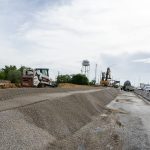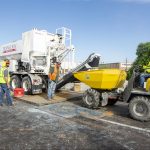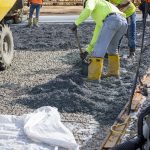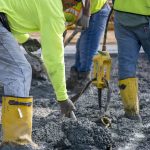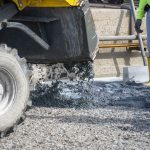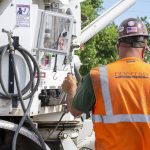Tell us a little bit about who Dunnet Bay Construction is.
Dunnet Bay is a bridge and structures contractor in the Chicagoland area. On this job specifically, we’re doing a bridge deck latex overlay on I-294, this is the Bensonville bridge. We’re doing a latex bridge overlay of the entire bridge deck using the Cemen Tech volumetric mixers.
This contract we’re working on includes completing a latex overlay to the bridge deck over six stages. In 2021, we are completing three stages along southbound I-294, while next year [2022] we will have a similar three stages on northbound I-294. Each year will include roughly 1,600 cubic yards of latex to be placed, for a total of 3,200 cubic yards. On both bridges, the traffic staging allows for two phases to pour a 30-foot width, while the other stage is a 10-foot wide pour down the center of the bridge deck.
How long have you had volumetric mixers?
Initially, I believe in 2010 we had a couple of mixers we used on a project on I-290. Then back in 2018, we purchased these two models for a project on the Veterans Tollway on I-355 where we ran out roughly 2,000 yards that year.
Talk about using the Cemen Tech units.
The Cemen Tech units have been very user-friendly and when there have been problems, which everything is going to have problems, the service department has been more than willing to work with us and help us out and get through everything. That’s been very helpful on their end.
Were they out here recently doing calibrations with you?
Yes, in April 2021 we had a training run on these mixers to kind of go through and refresh personnel’s memory — go through the motions of how the truck works, how you load it, how we discharge, how we clean, top to bottom. We had Tyler Iversen from Cemen Tech out here who did a heck of a job helping us, gearing everyone up, and training everyone so that we felt comfortable come calibration day where we performed a successful calibration on both trucks in front of the Illinois Tollway.
Why do you use latex modified concrete?
This particular bridge deck is scarified and receives an inch and three-quarters overlay. The latex overlay helps bond to the scarified bridge deck whereas regular concrete would not achieve the same product.
When the latex bonds to the bridge deck, does it make the deck stronger?
Yes, it adheres much better than standard concrete. For this specific instance, they choose the latex overlay as opposed to a microsilica or something of that nature. These trucks are geared up and able to produce the latex concrete in parameters set by the Tollway and with our mix design. And we’re able to monitor that through the process of production.
How often is latex chosen?
The owner dictates what mix is going to be used so on this specific project the Illinois Tollway spec’d out the latex overlay for this bridge.
What do DOT personnel monitor on the job site?
They’re monitoring slump, water-cement ratio, latex content, cement, and aggregate content as well to make sure everything is falling into the correct parameters. That’s part of the calibration prior to the field production and then in the field, they’re also verifying as we produce.


